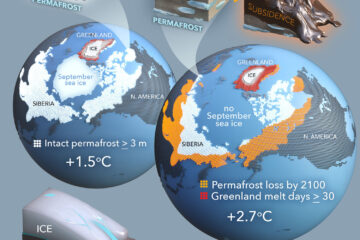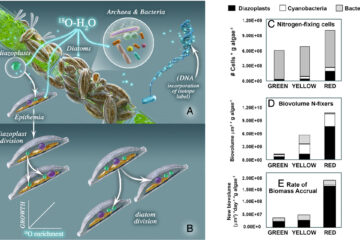Long-term warming in Alaska enlarges the diazotrophic community in deep soils
Tundra ecosystems are typically carbon (C) rich but nitrogen (N) limited. Since biological N2 fixation is the major source of biologically available N, the soil N2-fixing (i.e., diazotrophic) community serves as an essential N supplier to the tundra ecosystem. Recent climate warming has induced deeper permafrost thaw and adversely affected C sequestration, which is modulated by N availability. Therefore, it is crucial to examine the responses of diazotrophic communities to warming across the depths of tundra soils. Herein, we carried out one of the deepest sequencing efforts of nitrogenase gene (nifH) to investigate how 5 years of experimental winter warming affects Alaskan soil diazotrophic community composition and abundance spanning both the organic and mineral layers. Although soil depth had a stronger influence on diazotrophic community composition than warming, warming significantly (P < 0.05) enhanced diazotrophic abundance by 86.3% and aboveground plant biomass by 25.2%. Diazotrophic composition in the middle and lower organic layers, detected by nifH sequencing and a microarray-based tool (GeoChip), was markedly altered, with an increase of α-diversity. Changes in diazotrophic abundance and composition significantly correlated with soil moisture, soil thaw duration, and plant biomass, as shown by structural equation modeling analyses. Therefore, more abundant diazotrophic communities induced by warming may potentially serve as an important mechanism for supplementing biologically available N in this tundra ecosystem.IMPORTANCE With the likelihood that changes in global climate will adversely affect the soil C reservoir in the northern circumpolar permafrost zone, an understanding of the potential role of diazotrophic communities in enhancing biological N2 fixation, which constrains both plant production and microbial decomposition in tundra soils, is important in elucidating the responses of soil microbial communities to global climate change. A recent study showed that the composition of the diazotrophic community in a tundra soil exhibited no change under a short-term (1.5-year) winter warming experiment. However, it remains crucial to examine whether the lack of diazotrophic community responses to warming is persistent over a longer time period as a possibly important mechanism in stabilizing tundra soil C. Through a detailed characterization of the effects of winter warming on diazotrophic communities, we showed that a long-term (5-year) winter warming substantially enhanced diazotrophic abundance and altered community composition, though soil depth had a stronger influence on diazotrophic community composition than warming. These changes were best explained by changes in soil moisture, soil thaw duration, and plant biomass. These results provide crucial insights into the potential factors that may impact future C and N availability in tundra regions.


